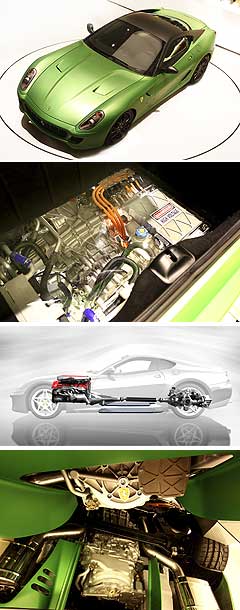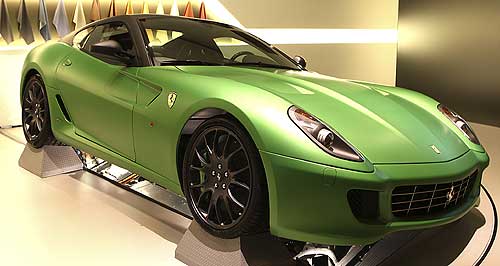Make / Model Search
Future models - Ferrari - 599 - HybridGeneva show: Ferrari prances in with hybrid 599Future Ferrari: First petrol-electric Prancing Horse model cuts thirst by 35 per cent without affecting performance, says Ferrari. First hybrid Ferrari finally emerges at Geneva as idle-stop arrives in California2 Mar 2010 JUST as it promised, Ferrari has used today’s Geneva motor show opening to publicly reveal its first ever hybrid, in the shape of the 599-based HY-KERS ‘vettura laboratorio’, or experimental vehicle, wearing earthy green paint instead of the Prancing Horse brand’s traditional blood red hue Unveiled alongside a new idle-stop system for the California coupe-convertible, which enters production from March, the ground-breaking eco-concept previews a hybrid drive system that could eventually be fitted to all Ferraris. The California’s new ‘Stop & Start System’ may be new to Ferrari and, as it points out, the high-performance sportscar class, but it’s similar to other fuel-saving idle-stop systems such as the one fitted as standard to Porsche’s Panamera, which will also be available with hybrid power next year. Claimed to reduce fuel consumption and CO2 emissions by six per cent (the latter to 280g/km) on the European combined cycle, the system is said to automatically restart the California’s V8 in just 230 milliseconds. Ferrari says that’s so fast that the driver barely notices the engine restarting, which tends to underestimate the vocal talent of its glorious new direct-injection 4.3-litre V8. But Ferrari’s Swiss limelight was reserved for the 599 HY-KERS, which is not expected to evolve to production stage until at least 2015, exceeds expectations by achieving a claimed 35 per cent reduction in combined-average fuel consumption and CO2 emissions. That’s more than the 25 per cent suggested by Ferrari CEO Amedeo Felisa, who also told GoAuto last month that Ferrari’s first hybrid road car was at least five years away and it is unlikely to be based on the top-shelf 599 GTB Fiorano.  Like the California’s idle-stop system, which Mr Felisa said would be the first in a range of fuel-saving technologies to be rolled out by the Italian supercar firm, the 599’s full parallel hybrid drive system is applicable to all Ferrari models, including front and rear-engined V8 and V12 vehicles. Like the California’s idle-stop system, which Mr Felisa said would be the first in a range of fuel-saving technologies to be rolled out by the Italian supercar firm, the 599’s full parallel hybrid drive system is applicable to all Ferrari models, including front and rear-engined V8 and V12 vehicles.Fitted to a 599 test car for more than 12 months and imposing a weight penalty of about 80kg, the HY-KERS system will be applied to a Ferrari production model by the same engineers that developed the KERS brake energy regeneration system for Ferrari’s Formula One cars. If employed by Ferrari’s all-new 458 Italia coupe, whose 425kW/540Nm 4.5-litre V8 already emits a class-leading 307g/km CO2 average, HY-KERS could be expected to produce as little as 200g/km. Ferrari’s CEO said last month that one of the biggest battles his engineers faced was integrating hybrid drive technology without diminishing Ferrari’s famed performance and emotional attributes, but Ferrari now says that “thanks to ongoing research combined with experience gained in Formula One, the new technology developed at Maranello actually accentuates the cars’ sporty character and driving involvement. That’s due in part, Ferrari says, to the fact its new hybrid transmission doesn’t alter weight distribution, since the 599 HY-KERS’ flat lithium-ion battery pack is positioned below the floorpan – resulting in an even lower centre of gravity than in the standard 599 without affecting cockpit or cargo space. It is also because the HY-KERS system’s relatively compact 40kg electric motor, which operates through one of the transmission’s two clutches and engages one of the two gearbox primary shaft, is coupled to the rear of the car’s F1 seven-speed dual-clutch gearbox. Designed and constructed in-house and featuring a unique cooling and lubrication system, the HY-KERS drive system’s tri-phase high-voltage electric motor represents about half of the total system’s weight penalty, but Ferrari says its goal was to offset every kilogram of weight gain by at least one extra horsepower. Hence, the electric motor produces “more than 100hp”, or about 75kW. Under braking the electric drive unit acts as a generator, using the kinetic energy from the negative torque generated to recharge the batteries – a phase that’s controlled by a dedicated electronics module, which also powers ancillaries such as power steering, brakes, air-conditioning and on-board systems, plus the hybrid system’s cooling pump, via a generator mounted on the V12 engine when operating 100 per cent in EV mode. Ferrari says the algorithms and control logics overseeing the traction, brake distribution and torque distribution functions of both the engine and electric motor were derived from Formula One, resulting in seamless and instantaneous torque distribution between the electric motor and V12 petrol engine. It stresses the HY-KERS solution “represents just one of the possible technologies for the future” and that in the meantime Ferrari continues to develop strategies to increase the overall efficiency of all its models, including reducing drag, improving the rolling resistance of tyres and lowering weight as well as reducing engine friction and adding features such as cylinder deactivation. The famed Italian maker admits the hybrid project is also aimed at ensuring that Ferrari can comply with future CO2 emissions standards, particularly in terms of the urban cycle, which involves low revs and low engine loads and is traditionally where high-performance cars are most penalised. While Ferrari attempts to slash the consumption of its production models, it has also committed to reducing the CO2 emissions and particulate matter levels of its production processes by a respective 40 per cent (or 30,000 tons) and 65 per cent throughout the course of 2010. Thanks largely to the fitment of Italy’s largest (photovoltaic) trigeneration plant on its Maranello factory’s roof in January 2009, Ferrari claims to be entirely self-sufficient in terms of energy use and says it will meet Kyoto protocol objectives a decade ahead of schedule.  Read moreAll future modelsMotor industry news |
Click to shareFerrari modelsResearch Ferrari All future modelsMotor industry news |


 Alfa Romeo
Alfa Romeo Abarth
Abarth Audi
Audi Aston Martin
Aston Martin BMW
BMW Bentley
Bentley Ferrari
Ferrari Chevrolet
Chevrolet Ford
Ford Fiat
Fiat GWM
GWM Foton
Foton Hyundai
Hyundai Honda
Honda Jaguar
Jaguar Isuzu
Isuzu Kia
Kia Jeep
Jeep Land Rover
Land Rover Lamborghini
Lamborghini Maserati
Maserati Lexus
Lexus McLaren
McLaren Mazda
Mazda Mercedes-Benz
Mercedes-Benz Mitsubishi
Mitsubishi Mini
Mini Peugeot
Peugeot Nissan
Nissan Ram
Ram Porsche
Porsche Rolls-Royce
Rolls-Royce Smart
Smart Skoda
Skoda Suzuki
Suzuki Subaru
Subaru Toyota
Toyota Tesla
Tesla Volvo
Volvo Zeekr
Zeekr







Facebook Twitter Instagram